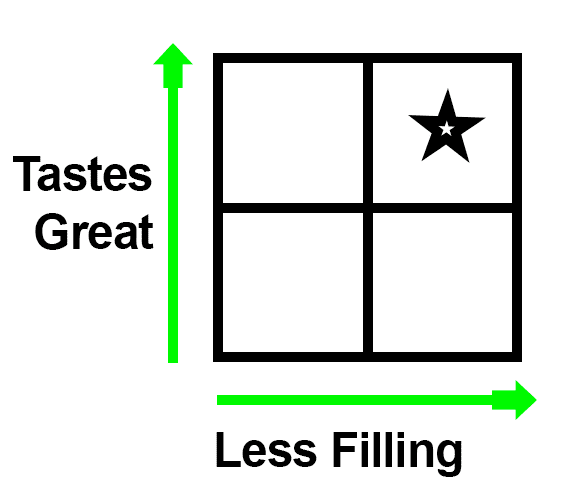A simple, two-by-two matrix can help ecommerce business owners and managers prioritize tasks and become more effective.
The Eisenhower Matrix organizes your to-do list based on each task’s relative importance and urgency. The model requires you to think about how a task can impact the overall business. It can also encourage long-term planning.
Decision-making Matrices
Miller Lite’s famous advertising campaign, “Tastes Great, Less Filling,” can provide an easy-to-understand example of how a standard, two-by-two decision-making matrix works.
If we put the quality of “Tastes Great” on the vertical axis (y-axis), we expect the amount of “Tastes Great” to increase as we go up, so that the top two quadrants taste best. Similarly, with “Less Filling” plotted on the x-axis, we would expect to find the least filling beers in the two right-hand quadrants.

In a typical two-by-two matrix, the upper right is the “magic” quadrant, wherein you find the best or most important grouping.
Thus, the quadrant in the upper right is both “Tastes Great” and “Less Filling.” For most two-by-two matrices, this upper-right quadrant is the best or most important.
Importance and Urgency
For the Eisenhower Matrix, the y-axis is importance, and the x-axis is urgency.
As you review your list of ecommerce related tasks, you would organize them into the quadrants.

If the Eisenhower Matrix were a standard matrix, it would look like this. Relative importance is on the y-axis, and relative urgency is on the x-axis.
For example, Affirm offers payment options to ecommerce shoppers, and it is a popular payment method on many sites. Recently Affirm changed its JavaScript integration. These changes required some online merchants to update their sites. The task of performing these updates was both urgent — since Affirm had set a deadline of July 31, 2019 — and important because Affirm’s payment option can increase ecommerce conversions.
Sinking Ship
One of the first benefits of the Eisenhower Matrix is that it forces us to compare or reconcile tasks that are “important and urgent” with tasks that are “important but not urgent.”
A common way to explain the difference between these quadrants and tasks is to think of a sinking ship.
Imagine you are on a lake by yourself in a small boat when suddenly a piece of debris pokes a fist-sized hole in the hull below the waterline. You would have two important tasks: (i) bail or pump rushing water out of the boat before it sinks, and (ii) repair the hole.
Pumping or bailing water is both urgent and important. If you don’t pump or bail, you will soon be swimming. Plugging the hole is important but relatively less urgent. You could put it off at least until the boat was full of water. So which should you do first?
Bailing water keeps you afloat, but doesn’t solve the real problem. Fixing the hole will solve the root issue, but the boat could sink before you’re done.
Here the solution might be to bail quickly so that you can create the time needed to repair the hole. You may need to bail for a while, work on the hole, and then return to bailing.
The Eisenhower Matrix
The Eisenhower Matrix addresses this conundrum in two ways.
First, it is non-standard in that it reverses the horizontal axis, putting the “important, but not urgent” quadrant in the upper-right position. This is because important but not urgent tasks are often the keys to long-term success.
If your ecommerce company is a sinking ship, it is plugging the holes, not bailing, that will eventually get you sailing again. Putting important, but not urgent tasks in the upper right acknowledges this.
But, second, the grid labels the quadrant in the upper left as “Do First.” These are the important and urgent tasks. This recognizes that sometimes you have to do at least some bailing before you can plug a hole even if the latter is ultimately more important.

The Eisenhower Matrix puts important but not urgent tasks in the magic quadrant on the upper right. You should spend most of your time working on tasks in this quadrant.
Do First. By nature, important and urgent tasks are done first. As you read down your to-do list and assign a task to this quadrant, you are essentially saying that it is a priority, if not the priority. You should do what you can to complete it immediately. You still need to consider time, resources, and costs, but these are the things you must do.
Decide (Schedule). The upper-right quadrant is labeled “Decide” as in “Decide When to Do” or simply “Schedule.” These are important but not urgent tasks. And, again, these are often the long-term initiatives that will grow your ecommerce business. Put these tasks on the calendar and treat them as sacred.
As an example, your ecommerce business might use content marketing to attract shoppers, so it is important to publish a YouTube video each week. The YouTube recording is rarely urgent, but always important, so schedule it. Decide that every Monday, you will devote 9:00 a.m. to noon on video creation. Do not let other tasks interrupt this time.
Delegate (Automate). Some tasks are urgent but not important for your ecommerce business. As much as possible, you should avoid doing these tasks yourself, but still ensure that they get completed.
For example, paying bills is an urgent ecommerce task. If you don’t pay the lease on your warehouse, you won’t have any place to keep your inventory. So delegate or automate it. Consider automatic bill pay.
Similarly, you might hire an assistant to screen calls or emails.
Delete. As you go through the lists of tasks, you will find some that are not important and not urgent. The Eisenhower Matrix empowers you to simply delete these.
The fastest way to check off an item on your to-do list is not to do it. Just put a line through it and forget it ever existed.
If deleting seems too extreme, consider moving it off the list. For example, if you use a Kanban board for your ecommerce projects, you might create a list of “tabled” items. Any task that falls into the not important and not urgent quadrant gets “tabled.”
Considerations
The Eisenhower Matrix is a tool. It is meant to help you think about the tasks you choose to work on and how they impact your business. Use this tool in combination with your good sense and understanding of the time and resources needed to complete each task.



